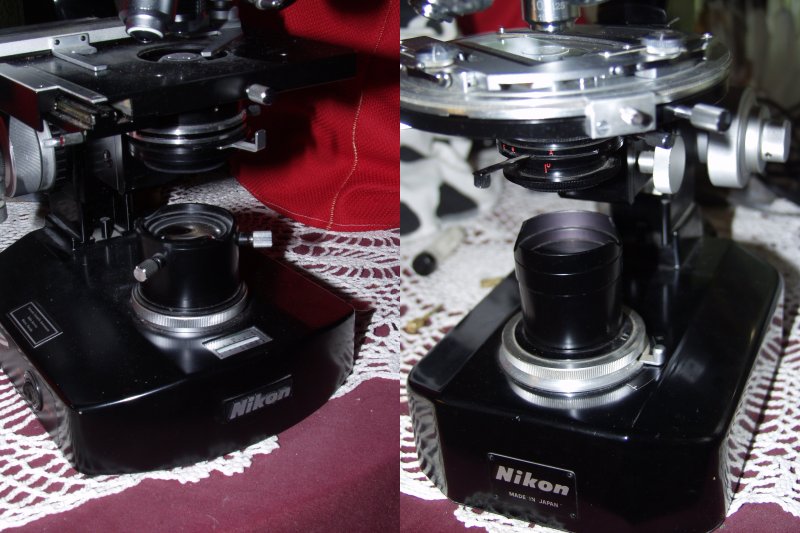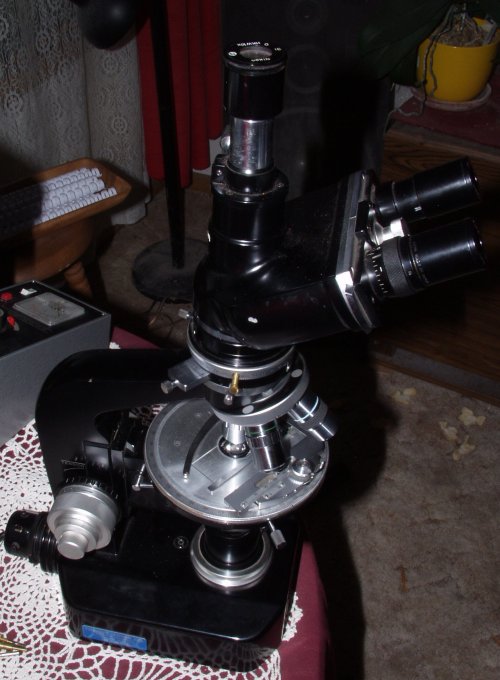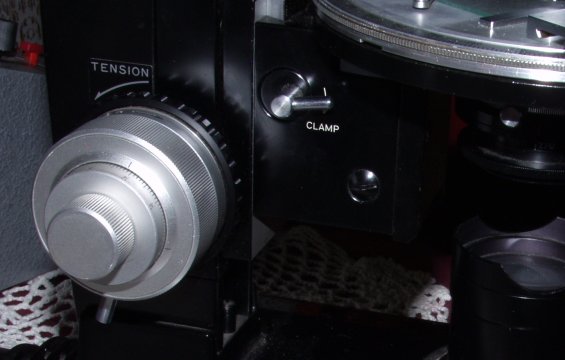
Nikon S Series Microscopes
Robert Pavlis, Girard, Kansas USA
The Nikon S series of modular microscopes was produced for many years during the 1960s and 1970s. This was a time when Nikon generally was a symbol of very high quality, and these microscopes generally lived up to this expectation.
Many of these microscopes are still in use today, and they quite frequently are available for purchase. Anyone considering purchasing one of these old instruments should have some knowledge of exactly what modules are present on the model they are acquiring. One of these old instruments with the "top of the line" modules when in good condition is generally of higher mechanical quality than most new modern instruments because modern instrument manufacturers generally dramatically overuse plastics. The abused and worn out ones with modules from the "bottom of the line" are another matter, as are the many "stripped" ones that are frequently put up for sale.
The information given here was extracted from a collection of old Nikon brochures and manuals.
S series Microscope Bases
Most modern microscopes are produced with only one type of base. The Nikon S series had several different ones:
Mirror Base
The original Nikon S microscopes were produced with a 45 degree mirror under the condenser, and were designed for using with external illuminators. These bases were much thinner than other models. Instruments with this type of base seem to be in demand for collectors. They are not very desirable for use as microscopes, however.
Type M Base
The Nikon S microscopes that were produced for metallurgical use have no substage illumination. These instruments had a base similar to the mirror base, except there was no mirror.
Type FL and FT Base
Some Nikon S microscopes were produced for fluorescence using substage illuminators. The base on these instruments was basically the type Cb (see below) base with no optical parts at all—just a hole beneath the condenser.
Microscopes of this sort were set on top of a special illuminator base so that the light went straight up from the illuminator into the condenser. The FL was the standard fluorescence base, the FT was a special model for diagnosis of syphilis.
Type Cb Base
These are the "bottom of the line" bases that had a built in illuminator. They are much thicker than the mirror bases and the type M base. They have a transformer and rheostat built into the base. There is a diffuser and a lens under the condenser to direct the light into it. Nikon microscopes with this base were designated as "S-Cb" models.
This base was also supplied with their "CL" model which was largely sold to universities for microbiology laboratory courses and to clinics.
The American importer of Nikon products also sold this model under their own brand name, EPOI.
Instruments having this base are not particularly desirable, not because they are really bad, but because the other ones described below are so much better.
Type Kt Base
These are a dramatic improvement over the Cb base. They are designed to provide Koehler illumination. Like the Cb they have a built in transformer and thus need no external power supply. Instead of having a protruding knob to adjust lamp intensity, there is a small finger wheel on the side.
There are provisions for centring the illuminator relative to the condenser, and of course there is an iris diaphragm built in the base.
Instruments that are in good condition that have this base are quite desirable.
Type S-Ke and L-Ke Bases
These bases are more elaborate than the Kt bases. They have a built in arrangement of condensing lenses in the base that can be moved in and out of the optical path to provide more concentrated beams of light at higher powers. There is a setting for 2.5X and 4X objectives, one for 10x and 20X objectives, and a third for 40X and above.
Instruments with these bases have external power supplies.
The S-Ke had condenser centring screws on the top of the illuminator, the L-Ke had them internal. (The S-Ke and Kt bases have a rather similar appearance. The S-Ke has a lever at the side of the illuminator to adjust the internal arrangement of lenses.)
Either S-Ke or L-Ke instruments are highly desirable when in good condition. Few other microscopes have ever been made by any company with illumination systems that match these! Most do not even come close!
The images below show an instrument with a Kt base on the left and one with the L-Ke on the right. Note the lack of Centring screws on the L-Ke. Also note the lever at the base of the lens assembly on the L-Ke.

Arms (or Limbs)
The arm of the S series of microscope was about the only part that was essentially unchanged in all of the models.
It contains the focusing mechanism, which in these microscopes moves the stage. The coarse focusing mechanism is rather robust. The fine focusing mechanism has provided many problems over the years.
The fine focusing mechanism uses a nylon gear. Nylon is more suitable for gears than about any other polymer—except there was a design flaw here that has created all of the problems. The focusing mechanism has a lock. Because the fine focusing mechanism is so strongly geared down, when the lock is in place turning the fine focusing knob against it can easily either strip or crack the nylon gear. Many of the S series microscopes that have not been damaged by this flaw have had their lock lever removed!!! (Nylon gears were used because they do not require lubrication. They are also very inexpensive.)
Anyone purchasing an S series microscope should be sure that the fine focusing mechanism has not been damaged. A substantial fraction of these microscopes have been damaged in this manner. There are companies that will repair this damage, but their repairs often cost more than the value of the microscope.
Sometimes microscopes with other damage with intact focusing mechanisms become available. The arm can be removed from the base by simply removing four Allen screws, and they are almost always interchangeable.
Again buyers of used Nikon S series microscopes should check this!!!
Objective Nose piece Turrets
Nikon apparently made just two types of these, one type securely fastened to the arm, and a second type for their "high end" S series instruments that can be interchanged because it is mounted on a dove tail fitting.
The quality of both types was very high, better than almost any other manufacturers.
Heads
Nikon made no less than six heads for its S series microscopes:
Type I Head
The type I monocular head is inclined 45 degrees and has a 1X magnification factor. These were often used on polarising versions of these microscopes.
Type A Head
These heads are for monocular examination of specimens with a photo tube. They also have a 1X magnification factor. Light is either directed completely to the photo tube or completely to the visual one.
Type Y Head
These are binocular heads inclined by 30 degrees. They have a 1.25X magnification factor. Like all Nikon S binocular heads, the interpupillary distance adjustment is from 54 to 74 mm.
Type B Head
These are 45 degree binocular heads. They have a 1.0X magnification factor. Otherwise they are similar to type Y
Type F Head
These are 30 degree trinocular heads. They have a 1.25X magnification factor. All of the light is directed either to the photo tube or all the the two visual tubes.
These are the standard trinocular head for polarising S microscopes.
Type U Head
This is a 45 degree trinocular head with a 1.0 magnification factor. It has a three way sliding prism that can send all the light to the two visual tubes, all to the photo tube, or divide it between all three.
The trinocular heads are currently in rather short supply. They are difficult to obtain, and they tend to be rather expensive. The U series is to be preferred, except on polarising systems.
Stages
The S series was produced with four different stages:
Type R stage
This is the standard rectangular stage with built in mechanical stage. The quality of these is quite high. They were designed when external illuminators were the primary way to illuminate microscope fields, with the adjustments on the right hand side of the microscope when used in this manner. Oddly they were not changed when built in illuminators became the standard, so the controls are left handed. This is fine for left handed and ambidextrous people. Profoundly right handed people tend to be annoyed by this.
Type P stage
This is a plane rectangular stage with no mechanical stage.
Type C stage
This is a circular stage that moves around in various directions up to 18mm. It can be clamped in any position within its movement range.
Type G stage
This is a 360 degree graduated rotating stage, graduated in degree increments, it is provided with a vernier. Unlike many rotating stages, it is centrable. A mechanical stage was produced that attaches to it. (This is the standard stage for polarising microscopes.)
Objectives and Oculars
Nikon produced an enormous variety of objectives for these instruments. At one time or another they produced about 100 different ones! There have been substantial improvements in objective production technology since then. Many old Nikon microscopes have been upgraded by discarding the original objectives and replacing them with better ones.
One of the driving forces for the wide scale adoption of infinity objectives by manufacturers is quite obviously to force microscope users to buy new (generally poor quality plastic) microscopes instead of simply putting new objectives on better quality old instruments.
Nikon also produced several types of oculars. Because microscope objectives produce very narrow beams of light, oculars need not be especially complex optically to produce outstanding images. Thus older generation oculars tend to compare quite well to more modern ones. (Unlike objectives!)
Condensers
Nikon produced about ten different varieties of condensers for these instruments. Their phase contrast one is odd in that it has no adjusting screws. The user can simply push the phase rings around with fingers. This would seem a poor design, but it actually was quite good.
Special Microscope Systems
Nikon produced several special S series packages.
Fluorescence Microscopes
The fluorescence microscopes were mentioned already during the discussion of microscope bases. Nikon also produced epi illuminator systems for the fluorescence instruments. Model FL and FT were mentioned earlier.
Metallurgical Microscopes
Type M microscopes had an epi illumination system for metallurgy. The type R microscopes had a somewhat different arrangement for observation of surfaces by epi illumination.
Differential Interference Microscopes
Type T microscopes had a special device that fit below the head. Very few of these were ever produced. As a consequence of that fact they are very difficult to obtain, and generally expensive.
Polarising Microscopes
Nikon produced several polarising microscopes of the S series.
The type of instrument shown in the image below seems to have been the top of the line.

It has the top of the line L-Ke base and a trinocular type F head. It obviously also has the type G graduated rotating stage. The mechanical stage that attaches to this stage is of fairly high quality. An old brochure shows a similar instrument to this one, but it does not have the L-Ke base, and is designated as the POL-3.
It has a special polarising condenser. The condenser focusing mechanism is modified from all of the other S series models so that it is mounted on a vertical dove tail mount to accommodate universal stages. (An amazingly complex device used in crystallography that permits rotating crystals in 3 dimensions.) An image of this condenser focusing mechanism is shown below:

The analyser is mounted in an extraordinarily well built housing below the head. It has a built in quarter wave and full wave compensator that can be pushed into and out of the beam in an instant. It also has a built in Bertrand lens.
This instrument is, undoubtedly, one of the best microscopes that Nikon has ever produced. Because of this fact, instruments of this sort are extremely difficult to locate.
Unlike many polarising microscopes about everything on them is adjustable. That can be good, and it can be bad. It means that when things get out of alignment they can be adjusted easily. It also means that things are more apt to get out of alignment, so more time may be needed aligning things.
Some Final Comments
These instruments are among the most common type of "vintage" microscope offered for sale. In general the instruments with intact fine focusing mechanisms, good binocular or trinocular heads, and with the high quality built in illumination systems (Kt, L-Ke, and S-Ke) tend to be dramatically underpriced.
As mentioned earlier one should not ever purchase one of these without checking the fine focus gearing system.
All comments to the author Robert Pavlis are welcomed.
Microscopy UK Front Page
Micscape Magazine
Article Library
Please report any Web problems or offer general comments to the Micscape Editor .
Micscape is the on-line monthly magazine of the Microscopy UK website at Microscopy-UK